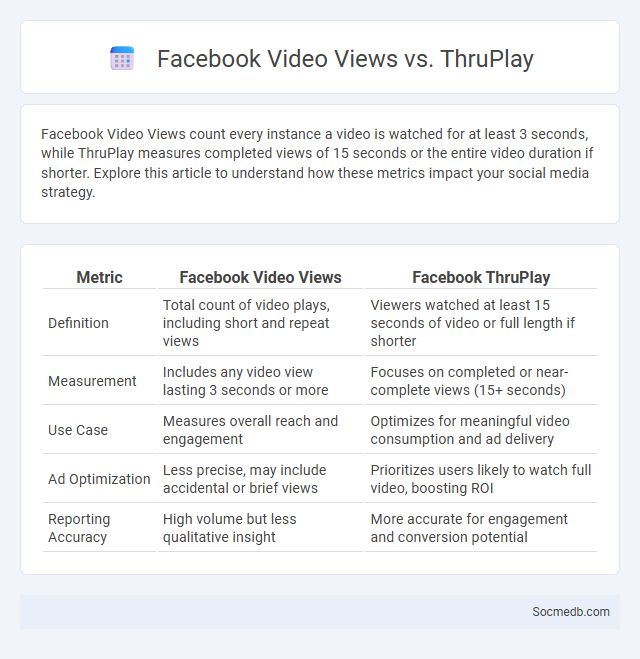
Photo illustration: Facebook Video Views vs ThruPlay
Facebook Video Views count every instance a video is watched for at least 3 seconds, while ThruPlay measures completed views of 15 seconds or the entire video duration if shorter. Explore this article to understand how these metrics impact your social media strategy.
Table of Comparison
| Metric | Facebook Video Views | Facebook ThruPlay |
|---|---|---|
| Definition | Total count of video plays, including short and repeat views | Viewers watched at least 15 seconds of video or full length if shorter |
| Measurement | Includes any video view lasting 3 seconds or more | Focuses on completed or near-complete views (15+ seconds) |
| Use Case | Measures overall reach and engagement | Optimizes for meaningful video consumption and ad delivery |
| Ad Optimization | Less precise, may include accidental or brief views | Prioritizes users likely to watch full video, boosting ROI |
| Reporting Accuracy | High volume but less qualitative insight | More accurate for engagement and conversion potential |
Understanding Facebook Video Views: Definitions and Metrics
Facebook video views are measured based on the length of time a user watches a video, with a standard view counted after at least three seconds. Metrics include total views, unique viewers, average watch time, and retention rate, which help marketers assess content engagement and performance. Understanding these definitions enables businesses to optimize video strategies for improved reach and audience interaction on the platform.
What is ThruPlay? Key Differences Explained
ThruPlay is a Facebook and Instagram video ad optimization feature that ensures advertisers pay only when users watch a video ad to completion or for at least 15 seconds. The key difference between ThruPlay and other video ad metrics like 3-second views or impressions lies in the engagement quality, as ThruPlay prioritizes deeper viewer interaction rather than just short or partial views. This results in more effective ad spending by targeting audiences who are truly interested in the content rather than those who quickly scroll past.
Facebook Video View: Types and Counting Methods
Facebook video views are categorized into key types including organic, paid, and shared views, each tracked to measure engagement accurately. The platform counts a view when a user watches a video for at least three seconds, with autoplay and click-to-play features influencing view metrics. Advanced analytics provide insights into audience retention, demographic data, and interaction rates, essential for optimizing video content strategies.
ThruPlay vs Video Views: Performance Comparison
ThruPlay measures the number of times your video is played to completion or for at least 15 seconds, offering a more engaged audience metric compared to Video Views, which simply counts any view over 3 seconds. Social media advertisers prefer ThruPlay for its emphasis on meaningful interactions and higher-quality engagement, resulting in better ROI. Optimizing your campaigns using ThruPlay data allows you to target users who are genuinely interested, enhancing overall ad performance and conversion rates.
Why Choose ThruPlay for Video Ad Campaigns?
ThruPlay ensures your video ad is viewed to completion or for at least 15 seconds, maximizing viewer engagement and ad effectiveness. Your campaign benefits from optimized delivery that targets users most likely to watch, improving return on ad spend and audience retention. This focus on completed views boosts brand recall and drives stronger performance metrics for social media advertising.
Cost Implications: Video Views vs ThruPlay
ThruPlay campaigns on social media optimize cost by charging only for completed video views lasting at least 15 seconds or the entire video length, reducing wasted spend compared to traditional video view campaigns that bill per 3-second partial view. Advertisers experience higher return on investment (ROI) with ThruPlay as it prioritizes engaged viewers more likely to convert, lowering cost per completed view. Budget allocation shifts towards ThruPlay campaign objectives can drive efficient ad spend by minimizing costs related to uninterested or fleeting audiences.
Audience Engagement: Which Metric Matters?
Audience engagement on social media is best measured by metrics such as likes, comments, shares, and click-through rates, which provide insights into how actively your followers interact with your content. Tracking engagement rate, calculated by dividing interactions by total followers, reveals the effectiveness of your posts in capturing attention and driving conversations. Understanding these key metrics helps you tailor your strategy to increase meaningful interactions and grow your social presence.
Optimizing Campaigns: Choosing the Right Objective
Selecting the right campaign objective on social media platforms is crucial for maximizing ad performance and return on investment. Objectives such as brand awareness, lead generation, or conversions should align with specific business goals and target audience behavior to optimize ad delivery and engagement rates. Data-driven insights and A/B testing help refine objectives, ensuring campaigns generate measurable outcomes like increased website traffic or higher sales conversions.
Reporting and Analytics: Measuring Success Accurately
Accurate reporting and analytics tools empower you to measure social media success by tracking key performance indicators such as engagement rates, reach, and conversion metrics. Data-driven insights reveal which content resonates best with your audience, enabling precise optimization of marketing strategies. Real-time analytics dashboards provide actionable reports to continuously refine campaigns and maximize ROI.
Best Practices for Leveraging Facebook Video Metrics
Analyzing Facebook video metrics such as watch time, audience retention, and engagement rates provides crucial insights for optimizing content strategy. Prioritize creating videos that maximize average watch duration and encourage shares and comments to boost organic reach. Regularly testing different video lengths and formats helps identify what resonates best with your target audience, enhancing overall performance.
 socmedb.com
socmedb.com